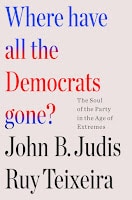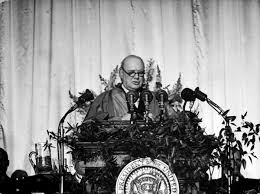Way back in 2002, authors John B. Judis and Roy Texeira wrote The Emerging Democratic Majority, which predicted (as per its title) a new 21st-century Democratic Party electoral majority. Two decades later, in their latest book, Where Have All the Democrats Gone? The Soul of the Party in the Age of Extremes, they summarize their earlier argument as a calculation « that as the numbers of college-educated voters, working women, and minorities grew, and as postindustrial metro centers grew, if Democrats were able to hold on to about 40 percent of the white working class, with close to an even split in heavily white working-class Rust Belt states, Democrats would more likely than not win the presidency and Congress and a majority of statehouses. »
That hope has obviously been unfulfilled. Not only has the white-working class almost completely abandoned the Democrats, but a political « Great Divide » has developed between « the dynamic postindustrial metro areas » dominated by « the burgeoning professional class » and small, rural, and midsize working-class communities still dependent on « manufacturing and resource extraction. » This « deficit among working-class voters in industrial America became the most important factor in Donald Trump’s completely unexpected defeat of Hilary Clinton » and other Republican successes.
I think we knew all this already, although it may need regular repeating for the message to sink in. The authors’ current book is largely an account of how this has happened, how the political party that historically « had its greatest success when it sought to represent the common man and woman against the rich and powerful, the people against the elite, the plebeians against the patricians, » went from its New Deal version of that to becoming itself the party of the rich and powerful, the elite, the patricians. Again this is a familiar story, but the authors do a very good job of engagingly retelling it.
More pointedly, they view as vital for American democracy « the reemergence of a political party whose primary commitment is to look after the country’s working and middle classes. » They recognize that the Republicans could conceivably become that party, but they worry that traditional Republican business commitments will get in the way and that the party’s radical side’s « propensities for violence and contempt for democracy outweigh the foibles of the Democrats’ cultural radicals. » Accordingly, that Democratic « cultural insularity and arrogance » are among the book’s main targets. The alternative, they argue, has been a loss by the Democrats of both white and non-white working-class voters, a loss which undermines the party’s prospects of being competitive at all. While recognizing the vast differences between 1930s America and 2020s America, the authors assert that « what the Democrats need today is a general approach to politics that is similar to that of the New Deal liberals, » i.e., « liberal, progressive, and social democratic in the economic views, » but « by today’s standards » both « moderate and even small-c conservative in their social outlook. »
The first part of the their book retells the familiar story of the New Deal coalition’s breakup and the progressive widening of that « Great Divide » through the Clinton and Obama years, the Trump-Clinton (« Deplorables ») debacle, and Joe Biden’s attempts to revive the New Deal, a commendable effort doomed by the decline of the Labor movement and the Democrats’ continued cultural radicalism.
The second section of the book deals specifically with that second concern – cultural radicalism. They focus on racial radicalism, immigration radicalism, sexual radicalism, and climate radicalism.
Early on, the authors warn against what they call the Fox News Fallacy, the fallacy that if Fox or the Republicans denounce Democrats on an issue like criminal justice, illegal immigration, or gender affirmation, then « there can be no basis for those charges. »
Is it possible to ascribe an analogous fallacy on the other side? In other words, is there a comparable danger of assuming that, if left-wing cultural radicals embrace extreme, bizarre, implausible, and (most important) unpopular positions, then all their positions on those issues must be likewise erroneous and should be steadfastly avoided.
But does every such stance deserve to be so considered? When it comes to the authors’ analyses in the book’s second section, many of their criticisms of extreme, radical, and evidently unpopular (what might elsewhere be termed woke positions) make manifest political and electoral sense. On the issue of climate, however, I wonder whether they may go too far in their accommodation. Are there areas, perhaps, where Democrats might instead challenge themselves to lead, as FDR did in his opposition to isolationism?
That said, the book’s overall analysis seems hard to fault. As the authors observe in conclusion, « America needs a Democratic Party that is liberal on economic and moderate and conciliatory on cultural issues. » They acknowledge that Democrats have historically « advanced substantive reform measures » that have addressed these vexing issues, but that « under the influence of cultural radicals, it has abandoned these positions. » That is what, the authors argue, need to change – for the Democrats’ sake and the country’s.





